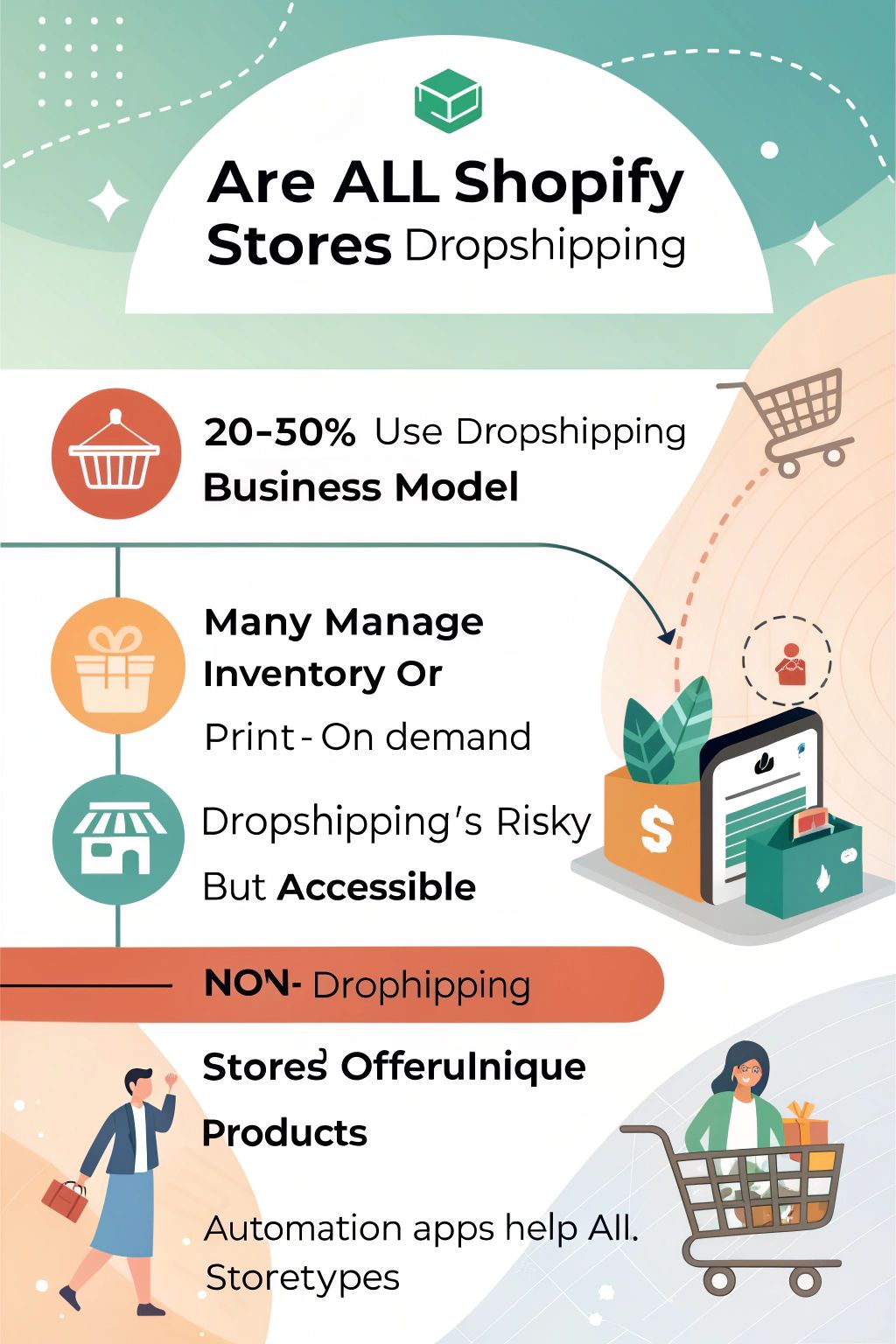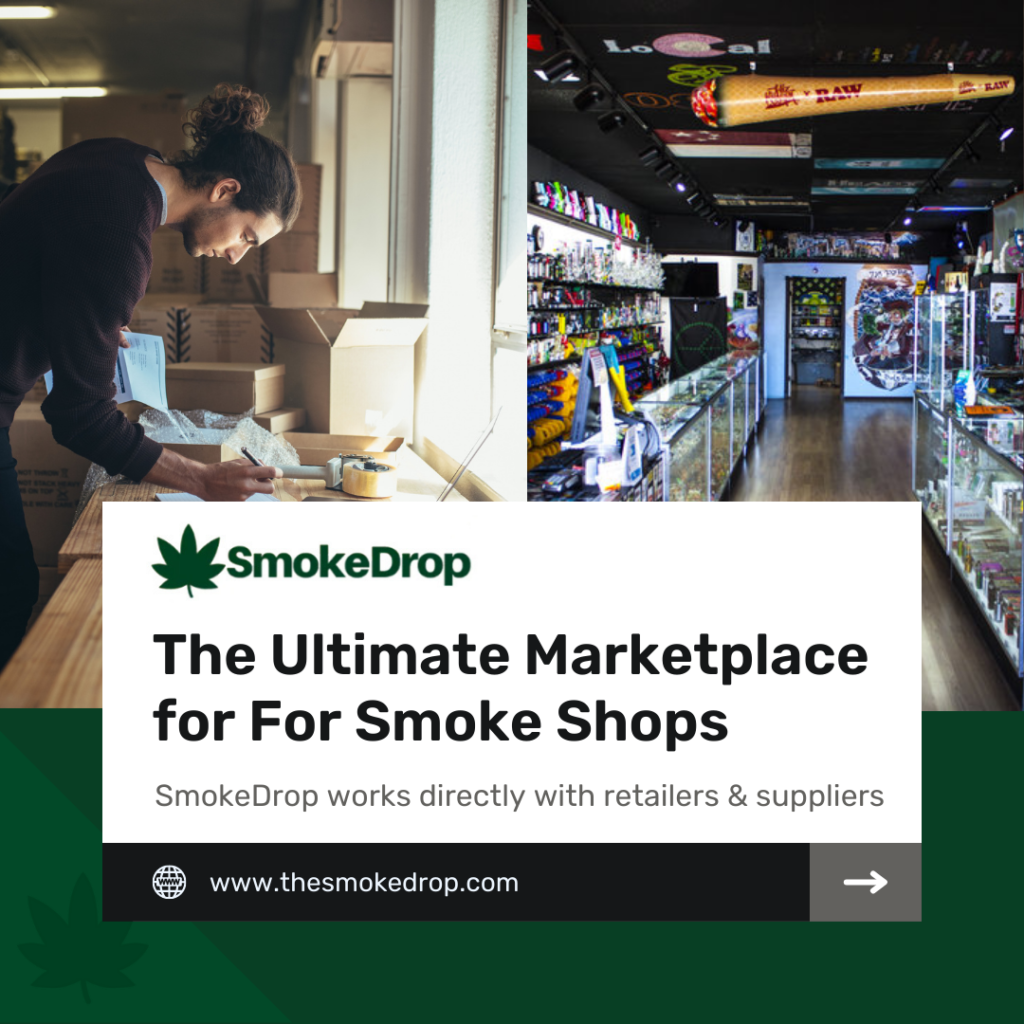Many people think all Shopify stores are the same. They might assume every store uses dropshipping to sell products online. This can be confusing for beginners or those planning to start an online business.
Dropshipping is a popular way to run an online store, but not every Shopify seller chooses this method. Some manage their own inventory, while others may create unique items or use other approaches.
This blog will clear up the confusion and explain the differences between dropshipping and other business models on Shopify.
Keep reading—you’ll learn something useful!
Key Takeaways
- Not all Shopify stores use dropshipping. Many manage their own inventory, sell private label products, or use print-on-demand services.
- About 20-30% of Shopify stores rely on dropshipping. Other models include inventory-based and hybrid setups.
- Dropshipping is popular because it requires no upfront stock and suppliers handle shipping. However, it has risks like low profit margins, slow delivery times, and limited quality control.
- Non-dropshipping stores focus on unique products, better branding, and faster shipping by managing their own inventory directly.
- Apps like SmokeDrop help both dropshipping and non-dropshipping Shopify stores with automation for inventory syncing and order fulfillment.

What is Dropshipping on Shopify?

Dropshipping on Shopify allows sellers to list and sell products without keeping stock. Retailers partner with suppliers who handle inventory, packaging, and shipping. Sellers only place orders after customers buy items from their store.
Shopify makes this process simple through supplier apps like SmokeDrop. This app connects stores to over 20,000 smoke shop products. It automates order fulfillment, inventory syncing, and tracking updates.
There are no minimum order requirements for wholesale purchases through SmokeDrop—helping stores grow faster by focusing on customer satisfaction.
Next: Are All Shopify Stores Dropshipping?
Are All Shopify Stores Dropshipping?
Not all Shopify stores use dropshipping. Many store owners choose other methods to sell products online.
Common misconceptions about Shopify stores
Many assume all Shopify stores rely on dropshipping. This is not true. While dropshipping is popular, many stores use other ecommerce business models. Some focus on private labels or sell inventory they manage directly.
Another myth claims Shopify stores can only sell one type of product. Dropshippers using platforms like SmokeDrop easily offer diverse options, ranging from clothing to niche items like smoke products.
Believing every store automates order fulfillment also misleads people—inventory-based shops handle their own stock and shipping processes manually.
Percentage of Shopify stores using dropshipping
There’s a misconception that every Shopify store runs on dropshipping. While dropshipping is popular, not all Shopify stores follow this model. The exact percentage of stores using dropshipping can vary. Below is a simple breakdown:
| Aspect | Details |
|---|---|
| Total Shopify Stores | Millions globally (exact figure not specified) |
| Stores Using Dropshipping | Estimated to be around 20-30% of total stores |
| Other Store Types | Inventory-based, print-on-demand, private label, and hybrid models |
| Reason for Dropshipping Popularity | No need for upfront inventory or warehouse management |
Dropshipping appeals to a specific group of entrepreneurs. Yet, the variety of Shopify stores demonstrates that it’s not the only option.
Types of Shopify Stores
Shopify stores come in all shapes and sizes. Each store follows a different way of selling, depending on the owner’s plan or goal.
Dropshipping stores
Dropshipping stores handle order fulfillment without keeping products in stock. Sellers partner with suppliers who ship items directly to buyers. This model fits well with Shopify’s tools for easy online store integration and order processing.
Many dropshippers use apps like SmokeDrop, which offers over 20,000 smoke shop products to import into their stores.
With SmokeDrop, retailers can sync orders automatically and manage inventory effortlessly. No minimum order requirement makes starting a dropshipping business flexible and cost-effective.
Using this approach saves time so sellers can focus on growing their businesses instead of packing or shipping orders themselves.
Private label stores
Private label stores create their own products and sell them under a unique brand name. Unlike dropshipping, these stores buy inventory directly from manufacturers or wholesalers. They often focus on quality control and use wholesale purchasing to get better prices.
This setup allows for more control over product types and packaging.
Store owners manage inventory themselves, so they need storage space. Private label products give businesses a chance to stand out with exclusive offerings. Though it takes more investment upfront, it can help build trust with customers in online retail markets like Shopify or other eCommerce platforms.
Print-on-demand stores
These stores let sellers create and sell products like t-shirts, mugs, or bags without keeping stock. Print fulfillment services handle the printing and shipping after a customer orders.
Shopify print-on-demand shops are popular for custom apparel stores and made-to-order products.
Personalized printing websites work well for dropshipping because there’s no upfront cost. Ondemand printing businesses often feature unique designs or themes to attract niche markets.
Many ecommerce print shops focus on items like posters, phone cases, or tote bags with trendy prints customers love.
Inventory-based stores
Inventory-based stores buy products in bulk and keep them in stock. Store owners manage their own inventory instead of relying on suppliers for each order. This gives them total control over their product catalog and quality.
SmokeDrop helps inventory-based Shopify stores with tools to handle tasks easily. Retailers can import over 20,000 smoke shop products into their online store. The app automates order fulfillment, syncing, and management without a required minimum purchase.
What is a Dropshipping Store Using SmokeDrop?
A dropshipping store using SmokeDrop sells smoke products and accessories without holding stock. Retailers choose from over 20,000 items like vape products or water pipes. The platform connects with Shopify for easy integration of these products into stores.
SmokeDrop offers fast shipping and strong profit margins. It automates order processes—like inventory synchronization, tracking updates, and fulfillment—saving time. Retailers can buy wholesale without minimum limits, giving them flexibility to manage supply easily.
Pros and Cons of Dropshipping on Shopify
Dropshipping on Shopify has its perks and challenges. It’s a simple way to start an online store, but it comes with risks that can’t be ignored.
Pros of dropshipping
Dropshipping is a popular choice for online sellers. It offers many benefits that make it easy to start and run an ecommerce business.
- It requires less money upfront since you don’t buy inventory in advance.
- Store owners have access to over 20,000 smoke shop products with tools like SmokeDrop.
- Operations like order processing and inventory syncing are fully automated, saving time and effort.
- Suppliers handle product storage and shipping, freeing up space for store owners.
- There are no minimum order limits, which allows more flexibility in sales.
- Sellers can offer a wide range of products without worrying about stock shortages or overstocking issues.
- Global suppliers ensure vast choices and competitive pricing for your store.
- Fast shipping options improve customer satisfaction, leading to repeat buyers.
- Wholesale pricing helps maintain healthy profit margins even at discounted rates.
- Integration with multiple platforms makes selling from one system easier than ever before!
Cons of dropshipping
Dropshipping sounds easy, but it has challenges. It may not fit everyone who wants a smooth business.
- Less control over product quality can cause customer complaints. Suppliers handle the products, so mistakes happen.
- Shipping times are often long and unreliable. This leads to unhappy customers waiting weeks for items.
- High competition makes it hard to stand out. Many dropshippers sell the same products at similar prices.
- Suppliers face stockouts, causing delays or canceled orders. This ruins trust with customers quickly.
- Profit margins are low due to fees and extra shipping costs. Gaining decent profits requires heavy sales volume.
- Managing returns and refunds is tricky without holding inventory. Customers wait longer, which frustrates them more.
- Building customer loyalty becomes harder with generic products. Stores cannot offer unique experiences easily.
- Marketing costs rise due to tough ecommerce competition online daily. Ads fail without clear strategies or unique goods.
Continue reading to learn about non-dropshipping Shopify stores!
Characteristics of Non-Dropshipping Shopify Stores
Non-dropshipping stores run differently. They keep their own products and handle shipping themselves.
Direct inventory management
Direct inventory management gives store owners more control over their stock. Stores using tools like SmokeDrop can import products directly into their catalog. This helps keep the product list up-to-date and accurate.
Features like inventory synchronization ensure stock levels are always correct, preventing overselling.
SmokeDrop also allows wholesale purchasing without minimum orders. This makes managing inventory more flexible for businesses of all sizes. Automated order processing and fulfillment simplify operations while keeping everything efficient.
Accurate tracking updates further streamline business tasks, saving time and reducing errors.
Higher control over product quality
Non-dropshipping Shopify stores check their products closely before selling. They work with trusted suppliers to make sure items meet high standards. This improves customer satisfaction and builds loyalty.
These stores manage inventory directly, reducing the chance of defective goods being sold. Since they use exclusive products, it makes their brand stand out more. Faster shipping times also keep customers happy and coming back.
Investment in branding and packaging
Better quality control allows store owners to focus on branding and packaging. Strong brand identity helps build trust and loyalty. Eye-catching designs make products stand out, giving a business an edge.
Smart packaging choices can boost customer experience. Durable materials protect items, while creative designs leave lasting impressions. This effort positions the store as reliable and professional.
How to Identify Dropshipping Shopify Stores
Spotting a dropshipping store can be easy if you know what to look for—click ahead to learn the signs!
Signs of a dropshipping store
Products often come from a vast catalog with no unique branding. The store may list hundreds or thousands of items across unrelated categories. Prices can look inconsistent compared to similar stores, hinting at wholesale purchasing and flexible markups.
Order fulfillment tends to be automated, using dropshipping platforms or ecommerce integration tools like SmokeDrop. Shipping times are longer because products ship directly from suppliers, often overseas.
Product descriptions might match supplier listings without much change, showing less attention to customization.
Differences between dropshipping and non-dropshipping stores
Dropshipping stores rely on third-party suppliers for order fulfillment. Non-dropshipping stores manage physical inventory themselves. Automated inventory sync helps dropshipping stores update stock fast, while non-dropshipping owners must track items manually.
Shipping times also differ between both types of stores. Dropshipping can process orders quickly with reduced delays, improving customer satisfaction. Non-dropshipping stores often face slower processing due to managing their own stock and shipping directly from a warehouse or local location.
Why Shopify is Popular for Dropshipping
Shopify makes dropshipping easy with quick setups and connections to suppliers—perfect for starting an online business. Keep reading to learn why this platform stands out!
Ease of integration with dropshipping apps
Dropshipping apps work smoothly with Shopify. SmokeDrop, for example, makes importing over 20,000 products quick and easy. Users can sync inventory, manage product listings, and keep tracking updates automatic.
Apps like SmokeDrop also handle order fulfillment right from the dashboard. BigCommerce’s dropshipping app offers similar features like automatic product listing and syncing orders in one step.
Integration saves time and boosts efficiency for sellers on ecommerce platforms.
Access to global suppliers
Shopify makes reaching global suppliers easy. With services like SmokeDrop, store owners can source over 20,000 products. These include vape items, CBD products, and water pipes. There’s no need for bulk purchases—order what you need with no minimum amount.
This access helps sellers keep flexible inventory while avoiding upfront costs. Supplier integration also supports platforms like WooCommerce and BigCommerce for smooth product listing management.
Store owners save time on order fulfillment and focus more on growing their business instead.
Examples of Shopify Stores That Are Not Dropshipping
Many Shopify stores sell their own products or hold inventory, showing that dropshipping isn’t the only way to run an online shop.
Successful inventory-based stores
Successful inventory-based stores sell products directly on Shopify. These stores keep stock on hand, ensuring faster shipping and better control over quality. Retailers use tools like SmokeDrop to handle inventory syncing and order fulfillment with ease.
With over 20,000 smoke shop products available through SmokeDrop, retailers can manage wholesale purchasing without minimum limits. This flexibility helps them stay stocked while saving time with automated processes for product listings and order management.
Unique product-focused stores
Some Shopify stores focus on unique products that stand out. For example, shops selling smoking accessories like glass pipes, bongs, and hookah supplies cater to a specific audience.
These stores often include items such as rolling trays, dab rigs, or lighters.
Retailers can source these products through tools like SmokeDrop. SmokeDrop offers over 20,000 smoke-related items with no minimum order rules. Popular brands like Afghan Hemp and AirVape are available for store owners to add more variety.
These stores rely on offering specialty goods rather than generic options found in dropshipping-only setups.
Conclusion
Not all Shopify stores use dropshipping. Many run different business models, like private label or inventory-based setups. Dropshipping can be simple and low-cost but has limits to control and quality.
Stores with direct inventory often focus on unique products and better service. Shopify’s tools make it easy for any store type to succeed. Every business must choose what works best for them—there’s no one-size-fits-all solution!
FAQs
1. Are all Shopify stores dropshipping?
No, not all Shopify stores use dropshipping. Many sell products they make or stock themselves, while others focus on digital goods or services.
2. What is dropshipping on Shopify?
Dropshipping means selling items without keeping them in your own inventory. Instead, a supplier ships the product directly to the customer when you get an order.
3. Can I run a Shopify store without using dropshipping?
Yes! You can sell handmade products, branded items you source yourself, or even offer online courses and digital downloads through your store.
4. Why do people think most Shopify stores are for dropshipping?
Many beginners start with dropshipping because it’s low-cost and easy to set up—but plenty of successful stores don’t follow this model at all!



